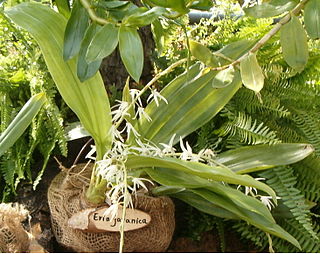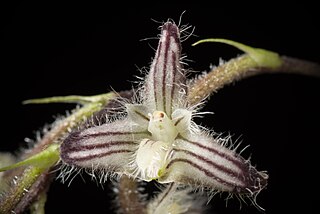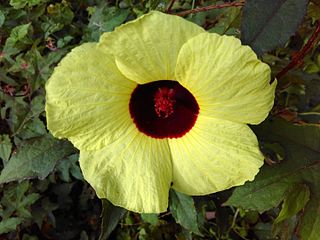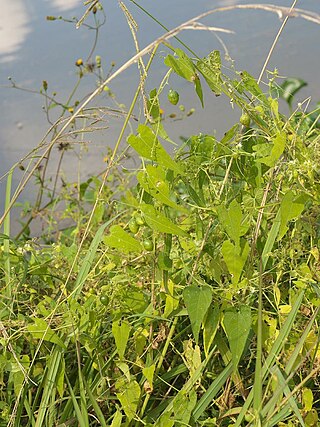
Arenga wightii is a species of flowering plant in the family Arecaceae. It is native to the Southern Western Ghats in Kerala in India. This palm has various uses in its communities. Local tribal communities depend on this plant for starch and religious ceremonies. It is also used to cover the roofs of houses due to its string resemblance to coconut leaves. Scientists have discovered that this palm has medicinal value. It is said to have antimicrobial and antioxidant phytochemicals. It is threatened by habitat loss.
Aglaia exstipulata is a species of plant in the family Meliaceae. It is found in Malaysia, Myanmar, Singapore, Thailand, and Vietnam.

Fissistigma is a genus of flowering plants in the family Annonaceae. There are about 75 species distributed in Africa, Asia and Oceania.
Siphonodon celastrineus is a species of plant in the family Celastraceae. It is found in Cambodia, India, Myanmar, and Vietnam.
Ternstroemia wallichiana is a species of flowering plant in the family Pentaphylacaceae. It is found in Malaysia and Singapore. It is threatened by habitat loss.

Oryza rufipogon is a species of flowering plant in the family Poaceae. It is known as brownbeard rice, wild rice, and red rice.

Eria is a genus of orchids with more than 50 species distributed in China, the Himalayas, the Indian Subcontinent, Southeast Asia, New Guinea, Polynesia, Melanesia and Micronesia.

Pinalia, commonly known as gremlin orchids, is a genus of flowering plants in the family Orchidaceae. Orchids in this genus are large epiphytic or lithophytic plants with prominent pseudobulbs, each with up to three thin, flat leaves and cup-shaped, relatively short-lived flowers with scale-like brown hairs on the outside. There are about 120 species occurring from tropical to subtropical Asia to the south-west Pacific.

Caryota obtusa is a species of flowering plant in the palm family Arecaceae. It is native to India, Laos and Thailand. The palm is commonly called giant fishtail palm or Thai giant caryota. It can reach 20 meters or more in height and is thus considered a tree. It is monocarpic meaning it flowers once, then dies. Its inflorescence can reach 6 meters or more in length.

Coelogyne barbata is a species of flowering plant in the family Orchidaceae. It is a shade-loving orchid that blooms in the months of October–November. It occurs in the Himalayas, Nepal, India, China and Myanmar. It grows epiphytic on trees or lithophyte on rocks in lower montane forests at an altitude of 1000 to 1800 meters above sea level. It is also found in Phalee but is rare. It has long, broad leaves and a bulb stem that grows from the roots. It blooms in September- November. It's a shade loving orchid.
Bulbophyllum khasyanum is a species of flowering plant in the family Orchidaceae.

Bulbophyllum lindleyanum is a species of flowering plant in the family Orchidaceae.

Bulbophyllum repens is a species of flowering plant in the genus Orchidaceae.
Bulbophyllum striatum is a species of flowering plant in the family Orchidaceae.

Hetaeria, commonly known as hairy jewel orchids, is a genus of about thirty species of flowering plants in the orchid family Orchidaceae. Plants in this genus are terrestrial herbs with a succulent rhizome and a loose rosette of leaves. Small, pale, hairy non-resupinate flowers are borne on a thin, hairy flowering stem. They are found in tropical Africa and Asia to New Guinea, Australia and some Pacific Islands.

Dendrobium uniflorum is a species of flowering plant in the family Orchidaceae. It is native to the Malesia and Southeast Asia regions, in Thailand, Vietnam, Malaysia, Philippines, Borneo, Sulawesi, Sumatra.

Glossocarya is a genus of flowering plants in the mint family, Lamiaceae, first described in 1843. It is native to Indochina, Sri Lanka, New Guinea, and Queensland.
- Glossocarya calcicolaDomin - Queensland
- Glossocarya coriaceaMunir - Queensland
- Glossocarya crenataH.R.Fletcher - Thailand
- Glossocarya hemiderma(F.Muell. ex Benth.) Benth. ex B.D.Jacks. - Queensland, New Guinea
- Glossocarya longifloraH.R.Fletcher - Thailand
- Glossocarya mollisWall. ex Griff - Myanmar, Thailand, Vietnam, Paluan Rabana in Malaysia
- Glossocarya premnoidesRidl. - Thailand, Perlis in Malaysia
- Glossocarya puberulaMoldenke - Cambodia
- Glossocarya scandens(L.f.) Trimen - Sri Lanka
- Glossocarya siamensisCraib - Thailand, Vietnam
Hymenopyramis is a genus of plants in the family Lamiaceae, first described in 1843. It is native to Indochina and to the Hainan Province of southern China.
- Hymenopyramis acuminataH.R.Fletcher - Thailand, Vietnam
- Hymenopyramis brachiataWall. ex Griff. - Thailand, Vietnam, Myanmar; naturalized in India
- Hymenopyramis canaCraib - Hainan, Laos, Cambodia, Thailand
- Hymenopyramis parvifoliaMoldenke - Thailand
- Hymenopyramis pubescensMoldenke - Thailand
- Hymenopyramis siamensisCraib - Laos, Cambodia, Thailand
- Hymenopyramis vesiculosaH.R.Fletcher - Thailand

Hibiscus hispidissimus is a species of flowering plant in the family Malvaceae. It is found in South East Asia.

Actinostemma is a genus of flowering plant in the gourd family Cucurbitaceae. It is native to east Asia. They are slender, weakly twining/climbing annual herbs.













